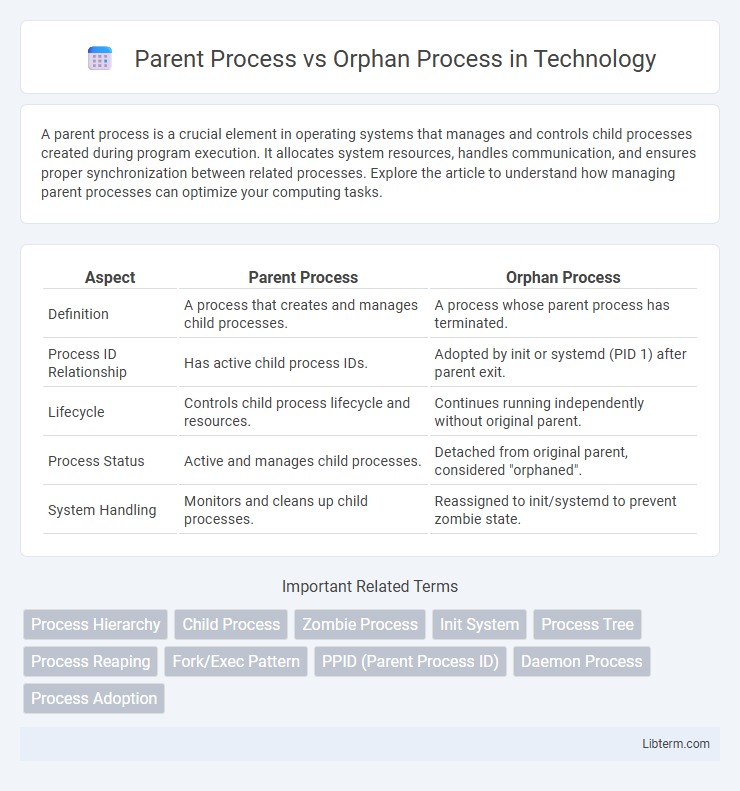A parent process is a crucial element in operating systems that manages and controls child processes created during program execution. It allocates system resources, handles communication, and ensures proper synchronization between related processes. Explore the article to understand how managing parent processes can optimize your computing tasks.
Table of Comparison
| Aspect | Parent Process | Orphan Process |
|---|---|---|
| Definition | A process that creates and manages child processes. | A process whose parent process has terminated. |
| Process ID Relationship | Has active child process IDs. | Adopted by init or systemd (PID 1) after parent exit. |
| Lifecycle | Controls child process lifecycle and resources. | Continues running independently without original parent. |
| Process Status | Active and manages child processes. | Detached from original parent, considered "orphaned". |
| System Handling | Monitors and cleans up child processes. | Reassigned to init/systemd to prevent zombie state. |
Introduction to Parent and Orphan Processes
A parent process is an original process in an operating system that creates one or more child processes, managing their execution and resources. An orphan process occurs when a parent process terminates before its child, leaving the child process without an active parent to manage it. Orphan processes are typically adopted by the init system (process ID 1) to ensure proper resource cleanup and system stability.
Defining a Parent Process
A parent process is an active process that initiates and controls one or more child processes within an operating system. It allocates resources, manages process states, and handles communication and synchronization between itself and its child processes. The parent process maintains control over the lifecycle of child processes, ensuring orderly execution and termination.
What is an Orphan Process?
An orphan process is a running process in a computer system whose parent process has terminated or completed execution, leaving the orphan process without a parent. The operating system's init process (PID 1) automatically adopts orphan processes to ensure they continue to execute and are properly managed. This adoption prevents orphan processes from becoming zombies, maintaining system stability and resource management.
Process Creation in Operating Systems
Process creation in operating systems begins with a parent process initiating a child process using system calls like fork() in Unix-like systems. Orphan processes occur when the parent process terminates before the child, causing the init process (PID 1) to adopt the orphan to ensure system stability. This mechanism prevents resource leaks by managing process hierarchies and maintaining proper process lifecycle control.
Key Differences: Parent vs Orphan Process
A parent process is an active process that creates one or more child processes, maintaining control over their execution and resource management. An orphan process occurs when a parent process terminates before its child, causing the child process to be adopted by the init system (PID 1) for continued execution. Key differences include control and lifecycle, where the parent process manages child processes, while orphan processes run independently under system supervision.
Life Cycle of Parent and Orphan Processes
The life cycle of a parent process involves creating child processes through system calls like fork(), managing their execution, and waiting for their termination using wait() to retrieve exit statuses. Orphan processes occur when a parent process terminates before its child, causing the operating system, typically via the init process (PID 1), to adopt and manage the orphan to ensure proper resource cleanup. Understanding the distinction between parent and orphan processes is essential for process management and avoiding issues like zombie processes in operating systems.
Role of the Init Process in Orphan Handling
The init process (PID 1) plays a crucial role in handling orphan processes by adopting them when their parent processes terminate abruptly. This adoption ensures that orphan processes continue to have a valid parent, preventing them from becoming zombie processes and allowing proper resource cleanup upon termination. The init process periodically waits for these orphaned child processes to exit, maintaining system stability and preventing resource leaks.
Implications for System Performance
Parent processes manage resource allocation and control child processes, directly impacting system stability and responsiveness. Orphan processes, which occur when parent processes terminate prematurely, can lead to defunct or zombie processes if not properly reaped by init or systemd, causing wasted system resources and degraded performance. Efficient handling of orphan processes ensures optimal CPU and memory utilization, preventing system slowdowns and maintaining overall performance integrity.
Security Considerations
Parent processes maintain control over child processes, ensuring secure resource allocation and proper cleanup, while orphan processes pose security risks by running without supervision, potentially leading to resource leaks or unauthorized privilege escalations. Orphaned processes are typically adopted by the init system (PID 1), which helps mitigate security issues but does not fully eliminate risks related to lingering processes or inherited permissions. Proper process management and timely termination of orphan processes are critical to maintaining system integrity and preventing exploitation.
Best Practices for Process Management
Parent processes should implement proper signal handling and resource cleanup to prevent the creation of orphan processes, which occur when child processes outlive their parents. Best practices include using process monitoring tools, such as init systems or process supervisors like systemd and monit, to adopt orphaned processes and ensure their orderly termination. Regularly auditing process trees and employing robust inter-process communication mechanisms help maintain system stability and resource efficiency.
Parent Process Infographic

 libterm.com
libterm.com